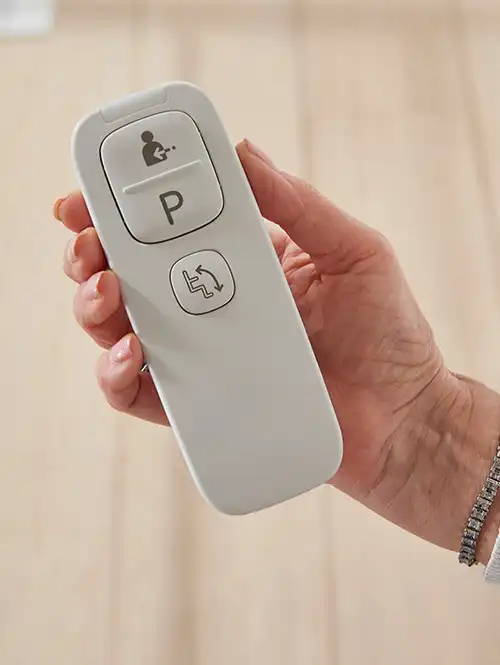Stair Lifts, Chair Lifts, and Stair Elevators: Enhancing Home Accessibility

Navigating stairs can become a daily challenge for seniors, individuals with disabilities, or those recovering from surgery. Fortunately, modern mobility solutions like stair lifts, chair lifts, and stair elevators can restore freedom of movement and improve safety in multi-level homes.
In this guide, we'll explore what these systems are, the different types available, and how to choose the right chair lift for stairs for your needs.
What Is a Stair Lift?
A stair lift is a motorized device that allows users to travel up and down a staircase while seated. The unit includes a rail system mounted along the stairs and a chair that moves smoothly along the track. With the push of a button, users can ride safely between floors.
These systems are also commonly called chair lifts or chair lifts for stairs. Some people refer to them as stair elevators, although technically, stair elevators can include vertical platform lifts used for wheelchairs.
Types of Chair Lifts for Stairs
Choosing the right stair lift begins with understanding the different types available. Each is designed for specific staircase layouts and user needs.
1. Straight Stair Lifts
These are designed for staircases without curves, turns, or landings. They are the most common type of chair lift for stairs and are typically quicker and more affordable to install.
2. Curved Stair Lifts
For staircases with curves, turns, or intermediate landings, a curved stair lift is custom-built to match the shape of the stairs. These systems provide a seamless, safe ride but are more expensive due to the custom rail design.
3. Outdoor Stair Lifts
Built with weather-resistant materials, outdoor stair lifts are ideal for exterior staircases such as those leading to porches, patios, or garden areas. These systems are designed to withstand rain, snow, and UV exposure.
4. Perch or Standing Lifts
In situations where users have difficulty sitting or bending, perch lifts offer a semi-standing position. These are useful for narrow staircases where space is limited.
5. Stair Elevators (Platform Lifts)
A stair elevator, often called a vertical platform lift, is designed to accommodate wheelchairs or large mobility aids. These systems move vertically between floors and are an excellent solution for users who cannot transfer out of their wheelchair.
Benefits of Installing a Stair Lift or Stair Elevator
Adding a chair lift for stairs to your home provides several advantages:
1. Improved Safety
Falls on stairs are a leading cause of injury among seniors. A stair lift provides a secure, stable ride and eliminates the risk of losing balance while climbing stairs.
2. Independence and Comfort
Users can move between floors without assistance, allowing them to maintain independence and continue living in their home comfortably.
3. Cost-Effective Home Modification
Compared to moving to a single-story home or assisted living facility, installing a stair elevator is often a more affordable solution.
4. Easy Installation
Most straight stair lifts can be installed within a day, without major structural changes to your home.
5. Customization and Features
Modern systems include features such as:
-
Remote controls
-
Swivel seats
-
Foldable armrests and footrests
-
Safety belts
-
Battery backups for power outages
How to Choose the Right Chair Lift for Stairs
When selecting a chair lift, consider the following factors:
Staircase Design
Is your staircase straight, curved, narrow, or outdoors? The shape and structure of your stairs will determine the type of lift needed.
User Mobility Needs
Consider whether the user can sit comfortably, whether a standing lift is required, or if a platform lift is needed for wheelchair access.
Budget
Straight stair lifts are the most budget-friendly, while curved stair elevators or platform lifts can be more costly due to customization.
Space Constraints
Make sure the lift can fit the width of your staircase. Foldable options are available for tight spaces.
Safety and Maintenance
Choose a model with safety features like seat belts, obstruction sensors, and backup power. Also, ask about maintenance plans and warranty coverage.
Stair Lift Installation and Maintenance
Professional installation is highly recommended for all types of chair lifts and stair elevators. Installers will measure your staircase, ensure proper alignment, and test safety features.
Ongoing maintenance is typically minimal, but it may include:
-
Annual service checks
-
Battery replacement every few years
-
Cleaning and lubrication of the rail system
Most manufacturers offer warranties and optional service contracts to cover future maintenance.
Conclusion
Whether you're aging in place, recovering from an injury, or supporting a loved one with mobility issues, a stair lift, chair lift, or stair elevator can make a significant difference in daily living. These systems offer a safe, comfortable, and cost-effective way to improve home accessibility without major renovations.
With the wide variety of options available today, it's possible to find a chair lift for stairs that meets your specific needs and fits your home design. Consult a reputable stair lift provider for an in-home assessment and explore your options to regain full access to every level of your home.








